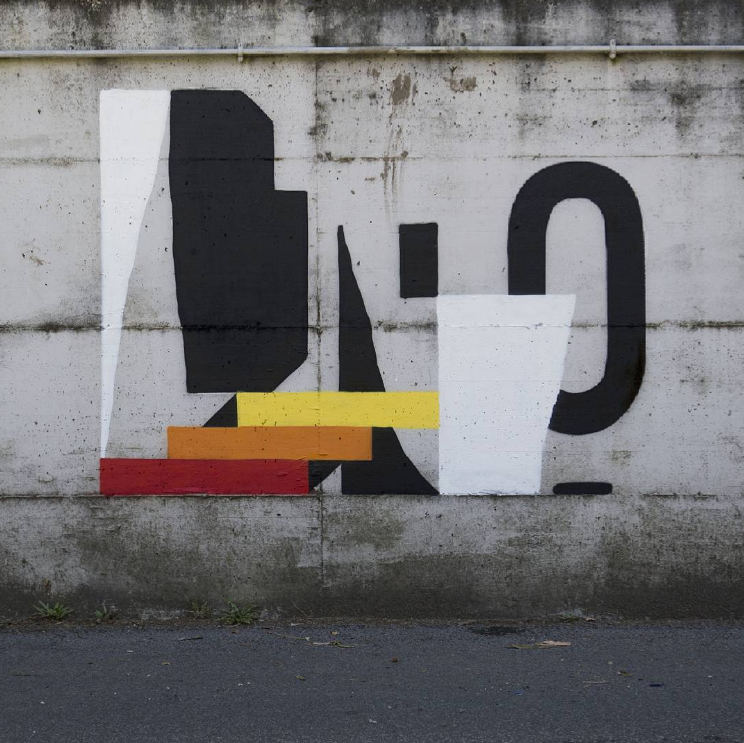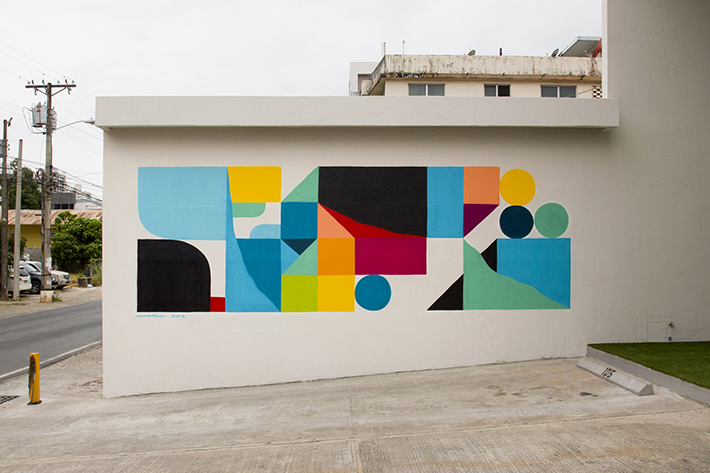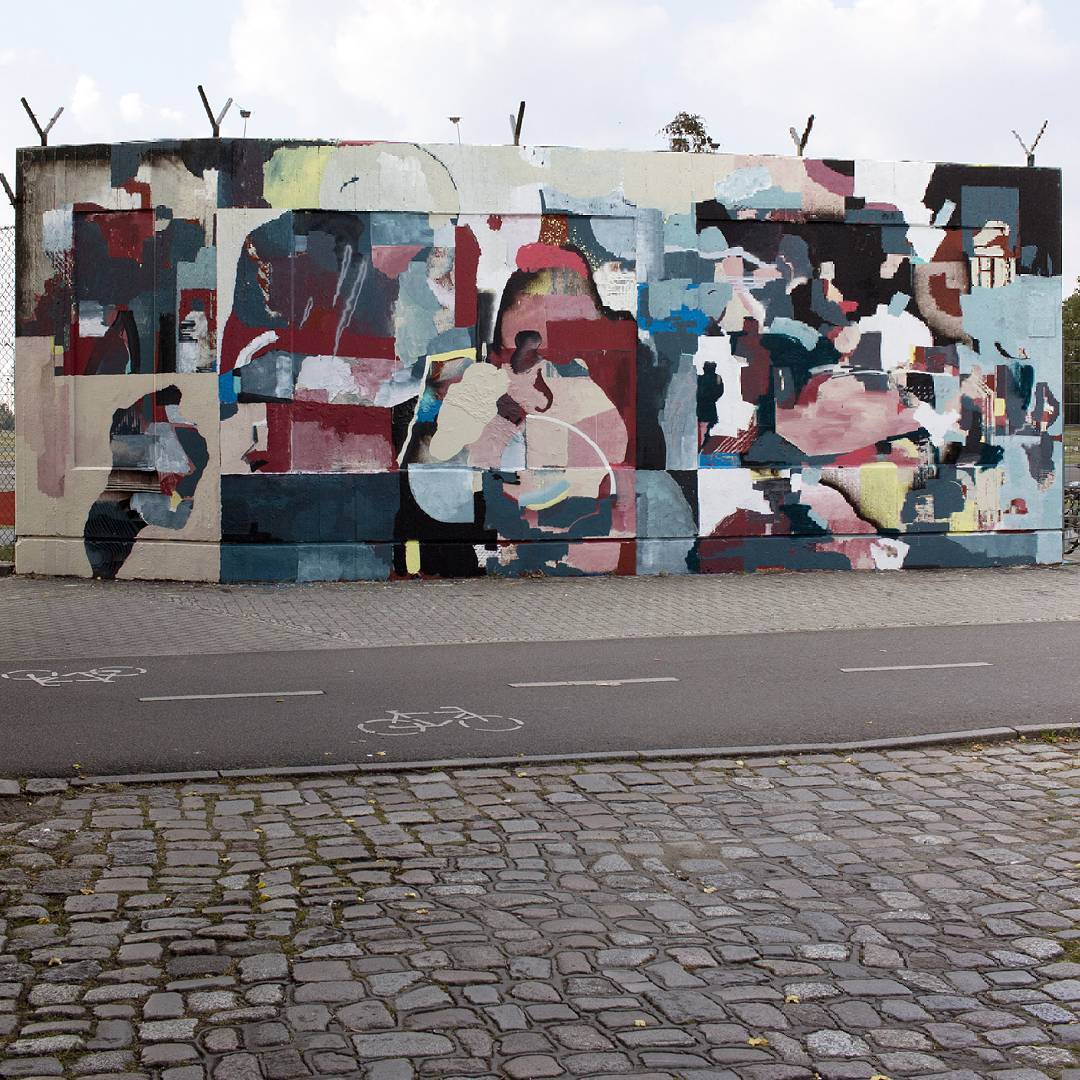From Lyon, France, the artist Nelio, is a force for abstraction on the streets of European cities. His mural work continues to push the boundaries of his graffiti roots and the high level of craftsmanship and the mastery of color and composition in his gallery works, have increasingly pressed his vision into the attention of fine art appreciators and galleries. Recently, I caught up with the artist and asked him a few questions. Here is what the French artist had to say about his work, how his graffiti background ignited his love for painting, and his entrance into a more contemporary gallery setting.
Like many of today’s makers the addictive act of graffiti bombing seems to be the spark that ignited your love for painting. Does a history in graffiti give you courage when navigating life as a contemporary artist?
Doing graffiti makes you think about your relation to rules and develops your free will. You discover that you can overcome the limits if you think they are too restrictive, and that you can even create your own game. So in a way it helps you to be more autonomous. It is also a discipline where you learn to take risks and follow your instinct.
Graffiti leads you to go out to find new walls to paint. It pushes you to travel and be curious. So you become more aware of the world you are living in. And if you haven’t been to art school you can still learn art step by step, maybe more by the action, by experimenting. The problem is that without the knowledge of art history, you might repeat what other artists did in the past, but if you keep digging and creating your own path, you might create some very original works.
If someone asked me to describe your work in three words, I’d choose: Graphic, Abstract, Geometric. I guess that’s why we don’t describe art in 3 words. Give us a more developed sense of the work you’re making. Talk to us about method, materials and concepts.
My creative practice started with the lettering and figuration. Screen printing and graphic design have gradually influenced my paintings. I was particularly passionate about logo design, which aims to get a message with the most minimal way possible, so I slowly applied this method to my works and I started to reduce my graffitis to basics.
My forms and lines became more pure and graphic. I started to be interested in the symbolism and the inner structure of things. Geometry became evident to express my vision and my ideas.
Using the same language as the architecture of buildings on which I applied my creations also enabled me to establish a more effective dialogue with them.
I created intuitive rules and constraints, by using primary forms, like a building set. This allowed me to develop a personal language that has become more and more elaborated. I still have much to do in this direction, but by having created a solid foundation, I can now afford to gradually change the rules of the game, and explore different paths.
In my recent work, I incorporate more spontaneity, by having sometimes sessions of quick automatic drawings or leaving more room for error and accident. This shakes the rules that I set for myself without overturning everything. This follows a logical evolution: life being made of cycles, it seems normal that at some point the degeneration appears.
What are some important distinctions for you between the mural work and gallery works?
Outside works are ephemeral while gallery works are supposed to stay longer. In a way this influences me to give more attention to detail in my studio works. Obviously they are also smaller than the wall paintings, so this give them a precious aspect, more intimate, while the murals will work at being viewed from a distance because it’s inseparable from the surroundings.
In the street you have to adapt to the wall to paint and the architecture around. And in some situations you have to be aware of the population and the history of the place where you will paint the mural. You know that you will impose your work to the view of everyone, so you have to take it into consideration.
While for the studio work, you don’t care that much about the viewers, you are completely free to do what you want. That’s also a reason why I prefer to paint a wall in a hidden abandoned place rather than in the street, I feel more free in this kind of space to take risk and experiment.
You have history as a freelance designer. I remember what an important read Ryan McGinness’ book ‘Sponsorship’ was for me. Don’t know if you’ve read that, but certainly an important set of perspectives for makers navigating between the realms of art and design. When you take on a design client, what are some important parameters for you? How much of your work as an artist is involved in your work as a designer?
In my practice I have always separated the two fields. I used to be a freelance graphic designer because I thought it was the best creative task for me to make a living, and this allowed me to keep a total freedom of experimentations for my artworks, without doing any compromise with it.
Over the years I started to be a bit frustrated to spend too much time working for other people, while I felt the need to work more on my personal artworks. So in 2011, I decided to stop graphic design to dedicate all my time to my art.
The value of art for me is not related to the time it takes to make it. Sure, I do enjoy some amazingly rendered realism, but at the same time, I enjoy ink expression drawings that might take less than a minute to make. Talk to me about the role of time in your work. How long do you meditate on your abstractions? How do you know when you’re ready to make expressive work? Do you need or prefer to be in a particular state of mind when you make?
I work with cycles. Sometimes the process are all mixed up, but usually I have some periods where I only want to focus on one thing. It can be periods of a few hours or a few weeks… Sometimes I only want to draw, and I need to be relaxed. If I am inspired I can draw anywhere, even in the middle of a crowd without being disturbed, but if I have the choice I will prefer to create in a quiet place, isolated in the nature. Sometimes I travel especially for that, to find myself in a cool atmosphere and be inspired.
Drawing becomes like an automatic gesture and I can produce a big load of work in this period.
Then I can look back at the drawings with a fresh vision later, and I am able to pick the good sketches for the appropriate project.
With this process, all the main work is made before I start to paint, then it is just executive work, reproducing the final sketch on a specific medium with a specific technique. The final step is less exciting but I still enjoy it, as it is like an act of meditation.
Another way of working is to experiment directly on the final medium. I don’t do any sketch, and start the painting like a game, playing with shapes, colors, textures and techniques. I try to simply transcribe feelings and emotions, without narration or hidden message. It’s when I want to reach a pure abstraction.
Usually I will have a lot of layers, which allow me to try new things, make mistakes and accidents. Then I slowly reduce the chaotic mess with buffing some part to isolate some shapes or just some lines.
With this second process I have a real feeling of painting while in the first one it’s more about drawing.
You’ve talked about screenprinting continuing to influence your street work. This makes sense, particularly as screen printing relates to flatness. Talk to me about flatness and your work.
One direction of my work tends to be very minimal. So a flat color is perfect for me, I don’t need anything else than shapes and pure colors. In this case I avoid textures and effects because they becomes unnecessary to what I want to express.
Sometimes I like to work with constraints, because it allows me to think and imagine new solutions to resolve problems, or to push the boundaries forwards.
With the example of screen printing, to resolve the problem of limited flat colors you can use transparent colors on top of each other to create new ones. Then you learn how the colors works together, it’s a nice exercise.
You can also work with textures and weft, to add more nuances in one colors.
This influenced for example my series of monochromatic works made only with one black spray paint, either with lines crossing each others, or with filling the shapes with a different pressure, which in both cases create different gray tones, and add more depth.
But even when I create some depth and volume, I want it to contrast with flatness, so it creates embedded spaces that play with movement and perception.
In the venue of the street, pure abstraction is a fish swimming upstream, so to speak. Most of what you see on the street is going to be either Pop imagery of some kind, or straight graf pieces. How much do you feel like you’re forced to defend what you do on the streets?
I don’t feel the need to defend anything in terms of choice of art. Everyone has his or her own practice and evolution, I used to do very illustrative work when I was younger, and I started graffiti by doing only letters. My work has evolved into pure abstraction, and might evolve into something else in the future. I don’t want to put borders in my creative field.
To speak about the street scene, I’m not interested that much about the global thing but more about a few individuals that develop an original and interesting practice.
For more from Nelio follow him on Instagram @_nelio.









